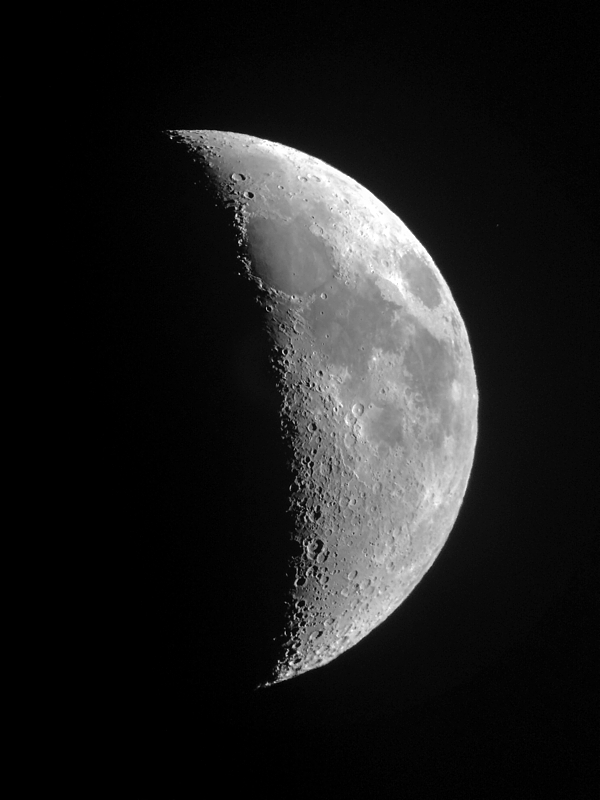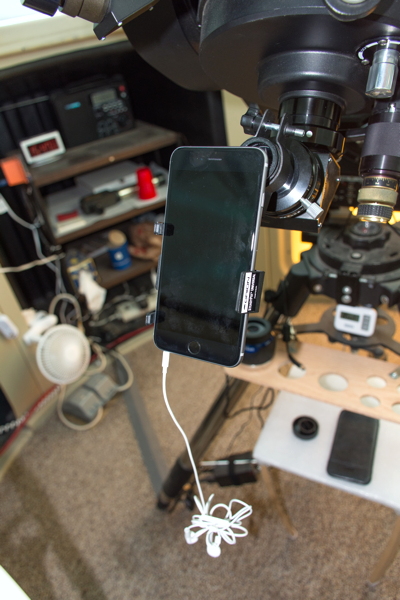Review - Orion SteadyPix Universal
Smartphone Telescope Photo Mount
Posted: 1 November 2015
 SteadyPix Universal Smartphone Telescope Photo Mount
SteadyPix Universal Smartphone Telescope Photo Mount
Orion Telescopes & Binoculars
$47.27 (USD)
After deciding to upgrade from my iPhone 5s to the new and much larger iPhone 6s Plus, I knew that I needed a new afocal adapter as my Magnilux MX-1 Afocal Adapter could not be further modified to fit the larger size of the 6s Plus. After doing some research I decided to go with the "Orion 05337 SteadyPix Universal Smartphone Telescope Photo Mount*". Its adjustable bracket claimed to fit smartphones up to 87mm (3.4 inch) wide, which would be adequate for the iPhone 6s Plus. Many afocal adapters (like the MX-1) are specific to one smartphone model, which can make them unusable when you upgrade to a larger or different shaped smartphone. The SteadyPix avoids that issue for the foreseeable future. Of course, the sky was cloudy when the adapter arrived. And I didn't yet have the iPhone 6s Plus. However, I was able to try out the adapter with my iPhone 5s.
The SteadyPix Universal adapter works with 1.25" eyepieces up to 1.5" in diameter. There is adequate adjustment capability to support long or short eyepieces with tall or short smartphones having center or corner mounted cameras.
As supplied, the SteadyPix does not support use on photographic tripods or piggyback mounts that use the 1/4" bolt attachment. However, if you remove the bracket that clamps to the eyepiece you can then attach the SteadyPix to a tripod/adapter using the 1/4" bolt. The bolt may be just a little too large to fit into the slot but you can "thread" it on. And then you just need a nut to hold it, as I show here:

I tried to mount the SteadyPix on my 12x70 binoculars but the eyepiece was just slightly too large for the supplied clamp. If your binoculars, monoscope, or nightscope have smaller diameter eyepieces, you should be able to attach the SteadyPix to them and take photographs. I did this successfully with my older MX-1 afocal adapter. One word of caution: do not mount the SteadyPix on the eyepiece that rotates for diopter adjustments for your eye. If you have no choice but to use a rotating eyepiece, you will have to mount the SteadyPix in a vertical position as the weight of the adapter and phone will rotate the eyepiece.
I also tried using the SteadyPix with a 1.25" 40mm eyepiece whose tube was just slightly greater than 1.5" in diameter. The locking bolt was slightly too short to tighten the clamp on the eyepiece. I discovered that the clamp would still grip the eyepiece reasonably tightly to hold the iPhone 5s in position. However, the long eye relief of my 40mm eyepiece really narrowed the field-of-view in the camera as I could not get the clamp to hold securely at the proper distance from the eyepiece.
iPhone 5s
Here is my iPhone 5s mounted on the SteadyPix Universal adapter:


You can see how a smartphone and an eyepiece are held and what positioning adjustments can be made.
The next photo shows the iPhone and SteadyPix mounted on the 8" LX200-ACF telescope in my observatory:

I used the iOS 9 Camera app for initial imaging tests with the Orion SteadyPix adapter with the iPhone 5s. The iPhone Earbuds/Mic cord volume control (seen in the photo above) was used as a remote shutter release. Being able to use the cord was a big consideration when I was researching larger adapters. Some appeared to block access to the headphone jack on the phone. The SteadyPix does not block it. I found that after initially aligning the camera over the eyepiece (before inserting the eyepiece on the telescope) and making any needed adjustments, when I then inserted the eyepiece on the telescope, I could easily slide the iPhone out and back in without disturbing that alignment. Of course, I did have to get it positioned vertically over the center of the eyepiece but no adjustments of the SteadyPix were required. That's important whenever you need to refocus the eyepiece to your eye (which is what you do when doing afocal imaging).
These photos show the Moon taken afocally at 77X (1.25" 26mm eyepiece) and 222X (1.25" 9mm eyepiece):


I also tested imaging some Deep Sky Objects (DSOs) using the SteadyPix and NightCap Pro v7. This is the Double Cluster at 48X (1.25" 26mm eyepiece + focal reducer):

Lagoon Nebula (M8):

Andromeda Galaxy (M31), and even M32 (bottom of image):

And this is a full-frame, afocal 77X, image of NGC7662 (Blue Snowball, planetary nebula) using NightCap Pro:

iPhone 5s piggybacked on the 8" LX200-ACF:

Depending on the smartphone camera field-of-view you may need change the position of the mounting bracket and piggyback adapter if you want to avoid the telescope tube appearing in your image.
This is Sagittarius and the Milky Way, piggyback, NightCap Pro:

iPhone 6s Plus
I received the new iPhone 6s Plus on 27 October 2015 and of course the sky was cloudy, but I did a few product photos:


This is the iPhone 6s Plus on the telescope:

Once the sky cleared I did some astrophotography with the iPhone 6s Plus and SteadyPix using the iOS 9 Camera app and NightCap Pro v7. I noticed that when I would slide the iPhone 6s Plus into the adapter from the top of the phone, the Camera shutter would be tripped by pressure on the volume buttons on the left side of the iPhone. That never happened with the iPhone 5s. The fix was to always slide the iPhone 6s Plus in from the bottom of the phone. These iPhone 6s Plus images are afocal 77X, NightCap Pro:
M57 Ring Nebula

M13 Great Hercules Globular Cluster

Double Cluster

M17 Swan Nebula

Waning Gibbous Moon, afocal 77X, Camera app:

This is the iPhone 6s Plus piggyback on the telescope using the SteadyPix:

I have not yet done any iPhone 6s Plus piggyback imaging but doing that is just like with the iPhone 5s and SteadyPix.
Summary
The SteadyPix Universal Smartphone Telescope Photo Mount is lightweight metal and has rubber pads to securely hold your smartphone and eyepiece without marring. The pads are slick but seem to provide good friction. The SteadyPix never shifted on my 26mm and 9mm eyepieces with the iPhone 5s or 6s Plus during slewing, nor was there any slippage of either iPhone in the adapter. If you do experience any shifting or slippage you can readjust the bracket to more tightly grip your phone or eyepiece.
The only complaint I have with the SteadyPix is the small knob used to tighten/loosen the clamp that holds the eyepiece. The knob is too small and too slick to easily grip and turn, especially as you get close to having the eyepiece almost tightly held. The small knobs on all the adapter bolts will be a challenge to use while wearing gloves during winter months.
Two other minor issues with the SteadyPix are seen in the following photo. After just a few uses a section of the padding that grips the eyepiece has peeled loose:

Whether this continues to be a worsening problem remains to be seen. You can also see that some of the black coating has already worn away from turning the knob.
Unlike the Magnilux MX-1 Afocal Adapter, which included a nice cloth bag, the SteadyPix Universal adapter comes in a plastic bag, which began to develop puncture holes from the metal parts on the adapter after only a couple nights of use. Now that I keep the afocal adapter in my observatory, usually with an eyepiece attached, the lack of a good case is not an issue for me. However, if you expect to travel with the SteadyPix you may want to use a better bag or case to provide some protection.
Using a smartphone adapter for your telescope (or binoculars or just a tripod) opens up astrophotography to more people than was possible just a few years ago. I have been doing astrophotography with an iPhone since getting the first model in late 2007. Photographing the Moon, Sun (with a proper filter), brighter planets, and with the addition of amazing software like NightCap Pro, astrophotography of the night sky and some bright deep sky objects is not only simple, but rewarding. You can see some examples in my iPhone Astrophotography gallery.
The flexibility of the Orion SteadyPix Universal Smartphone Telescope Photo Mount will likely provide years of smartphone astrophotography to you as you upgrade your phone to newer models. And its flexibility means that others who view through your telescope at star parties can do some basic astrophotography with their smartphones, providing them with a new source of excitement from observing the night sky. If you want an afocal adapter that you and others can use, regardless of the smartphone model, this one from Orion is an excellent choice.
* Purchasing using this Amazon link helps support Cassiopeia Observatory. Thanks.
Comments are welcome using Email. If you are on Twitter you can use the button below to tweet this report to your followers. Thank you!
Cassiopeia Observatory Home Page
Copyright ©2015 Michael L. Weasner / mweasner@me.com
URL = http://www.weasner.com/co/Reviews/2015/SteadyPix/index.html

